
Junghuhnia is a genus of crust fungi in the family Steccherinaceae. It was circumscribed by Czech mycologist August Carl Joseph Corda in 1842. The generic name honours German-Dutch botanist Franz Wilhelm Junghuhn.

Irpex lacteus is a common crust fungus distributed throughout temperate areas of the world. It is the type of the genus Irpex. Irpex lacteus is considered a polypore, but depending on growth conditions it can also produce a hydnoid hymenophore. Due to this variability and abundance of the species it has been described as a new species to science numerous times and subsequently has an extensive synonymy. The complete genome sequence of Irpex lacteus was reported in 2017.

The Phanerochaetaceae are a family of mostly crust fungi in the order Polyporales.

The Steccherinaceae are a family of about 200 species of fungi in the order Polyporales. It includes crust-like, toothed, and poroid species that cause a white rot in dead wood.
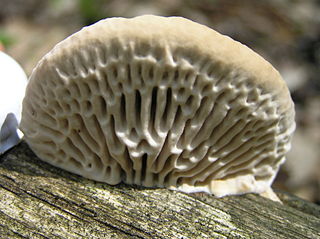
Daedalea is a genus of fungi in the family Fomitopsidaceae. The genus was circumscribed in 1801 by mycologist Christian Hendrik Persoon, based on the type D. quercina and four other species. The generic name is derived from the Ancient Greek δαιδαλεος.

Meruliopsis is a genus of poroid crust fungi. The genus was circumscribed by Russian mycologist Appollinaris Semenovich Bondartsev in 1959.

Gloeoporus is a genus of crust fungi in the family Irpicaceae. The genus has a widespread distribution.
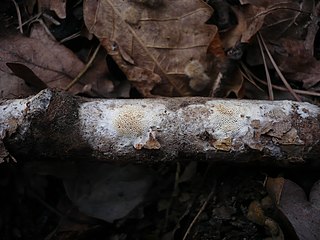
Ceriporiopsis is a genus of fungi in the family Phanerochaetaceae. The genus is widely distributed, and, according to a 2008 estimate, contains about 25 species. Ceriporiopsis was circumscribed in 1963 by Polish mycologist Stanislaw Domanski. The genus is a wastebasket taxon, containing "species that share common macroscopic and microscopic characteristics, but are not necessarily related." Ceriporiopsis species are crust fungi that cause a white rot. They have a monomitic hyphal system, containing only generative hyphae, and these hyphae have clamp connections.

Ceriporia is a widely distributed genus of crust fungi.

Antrodiella is a genus of fungi in the family Steccherinaceae of the order Polyporales.
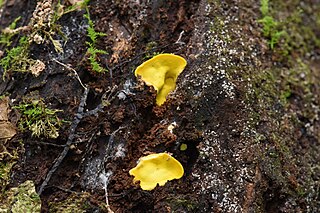
Flaviporus is a genus of poroid fungi in the family Steccherinaceae.
Gelatoporia is a fungal genus in the family Gelatoporiaceae. This is a monotypic genus, containing the single widely distributed species Gelatoporia subvermispora. The genus was circumscribed in 1985 by Finnish mycologist Tuomo Niemelä to contain poroid crust fungi with a monomitic hyphal structure, clamped hyphae, and producing white rot.

Steccherinum is a widely distributed genus of toothed crust fungi in the family Steccherinaceae.

Aurantiporus is a genus of poroid fungi in the family Meruliaceae. Circumscribed by American mycologist William Alphonso Murrill in 1905, the genus contains five species found mostly in northern temperate regions. Molecular analysis of several Aurantiporus species suggests that the genus is not monophyletic, but some other related polypore species need to be sequenced and studied before appropriate taxonomic changes can be made. In 2018, Viktor Papp and Bálint Dima proposed a new genus Odoria to contain Aurantiporus alborubescens based on multigene phylogenetic analyses. The generic name is derived from the Latin aurantius ("orange") and the Ancient Greek πόρος (pore).
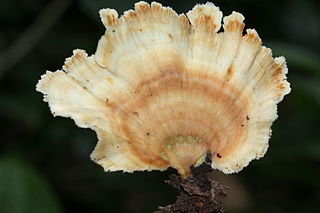
Flabellophora is a genus of poroid fungi in the family Steccherinaceae. The genus was circumscribed by New Zealand-based mycologist Gordon Herriot Cunningham 1965. Most species in the genus were described by E. J. H. Corner in 1987.
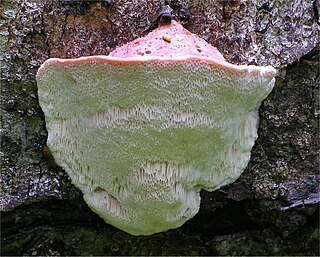
Leptoporus is a genus of polypore fungi. The type species, Leptoporus mollis, is widespread throughout north temperate areas. The generic name is derived from the Ancient Greek words λεπτός ("thin") and πόρος ("pore").

Nigroporus is a genus of poroid fungi in the family Steccherinaceae. The genus was circumscribed by American mycologist William Alphonso Murrill in 1905. Nigroporus has a pantropical distribution. The genus name combines the Latin word niger ("black") with the Ancient Greek word πόρος ("pore").

Tyromyces is a genus of poroid fungi in the family Polyporaceae. It was circumscribed by mycologist Petter Karsten in 1881. The type species is the widely distributed Tyromyces chioneus, commonly known as the white cheese polypore. The phylogenetic position of Tyromyces within the Polyporales is uncertain, but it appears that it does not belong to the "core polyporoid clade". Tyromyces is polyphyletic as it is currently circumscribed, and has been described as "a dumping place for monomitic white-rot species with thin-walled spores."
Efibula is a genus of 16 species of crust fungi in the family Irpicaceae.
















